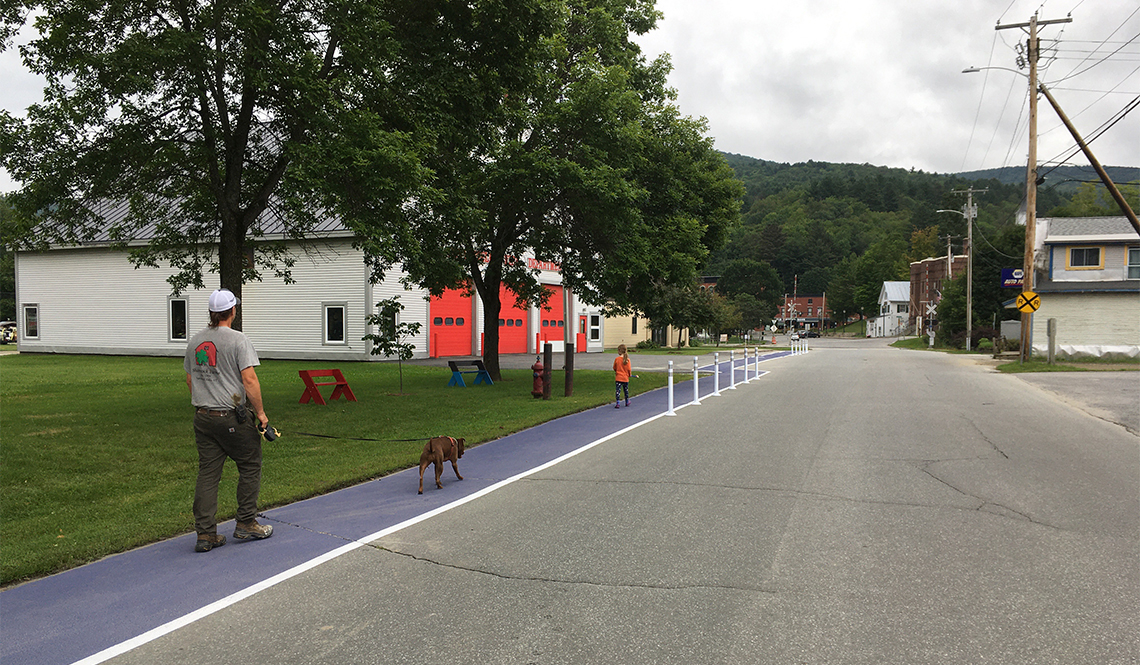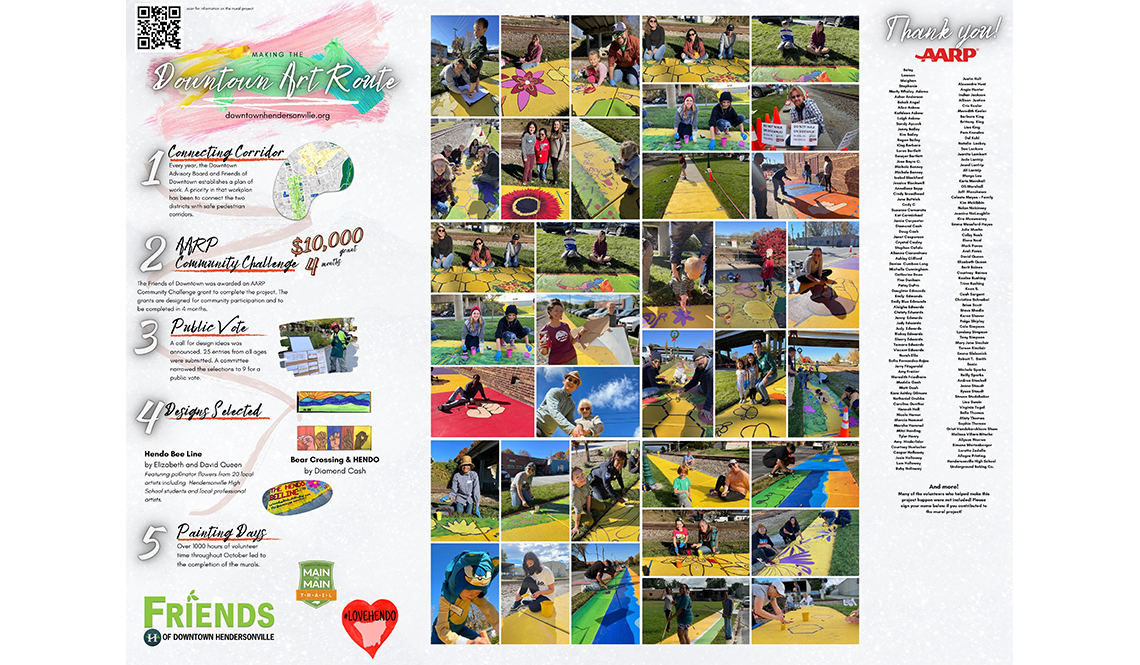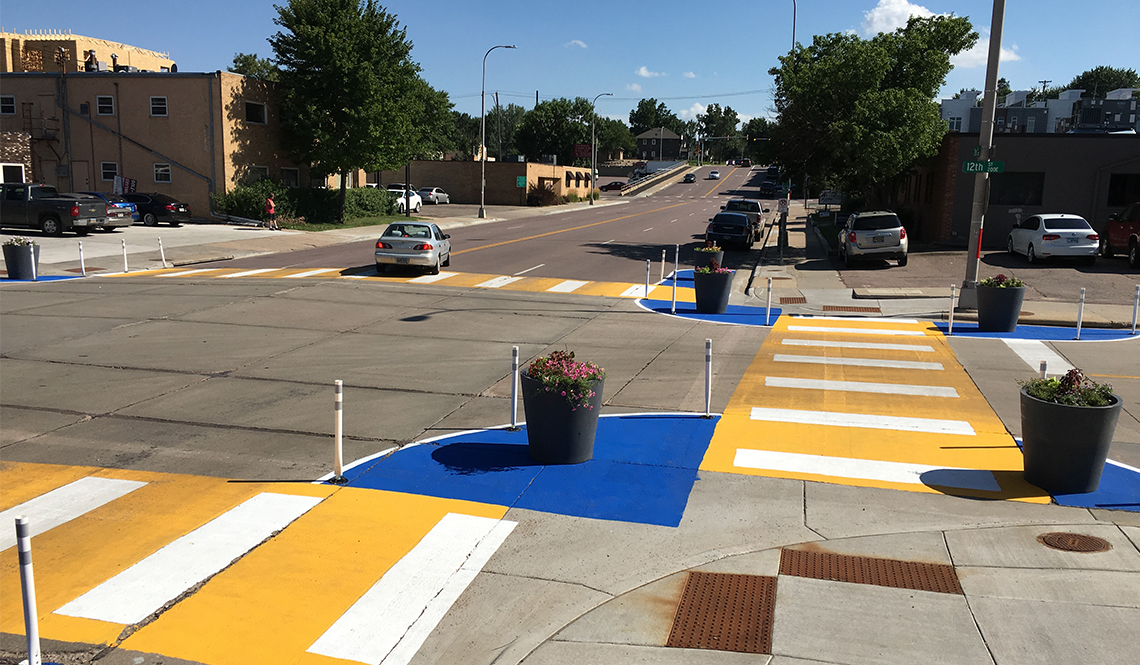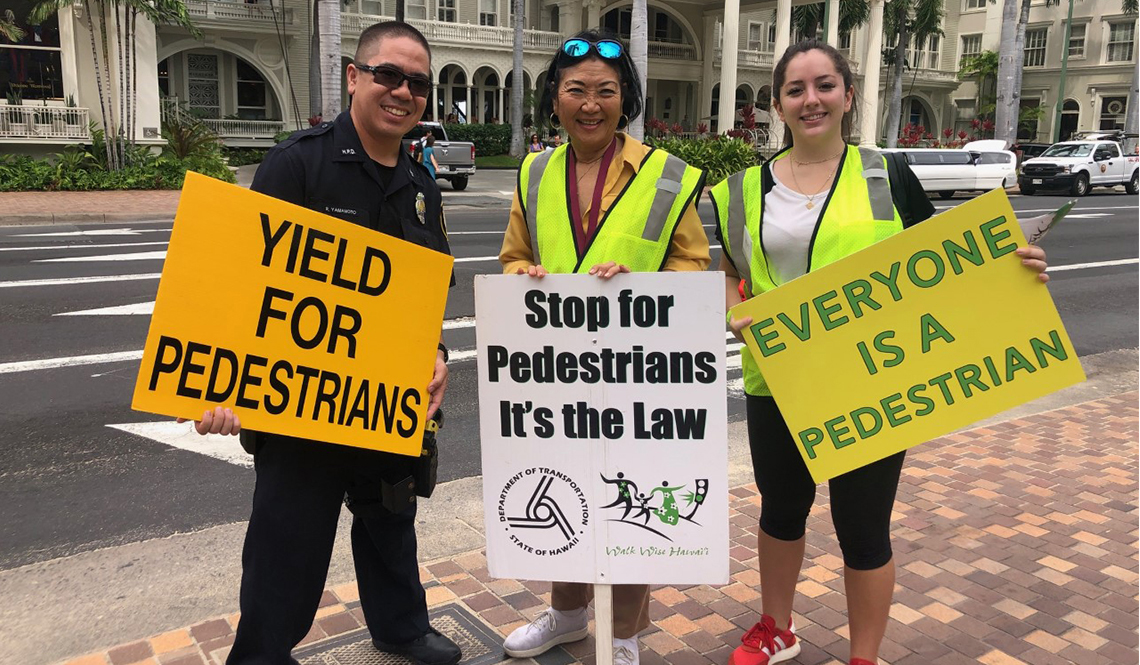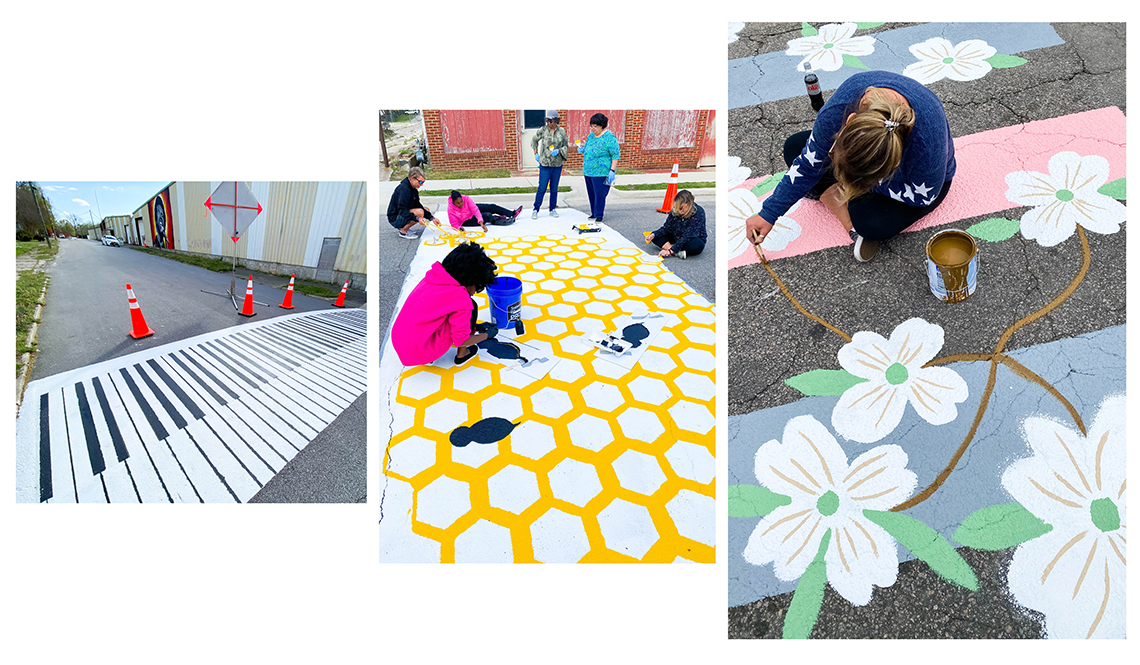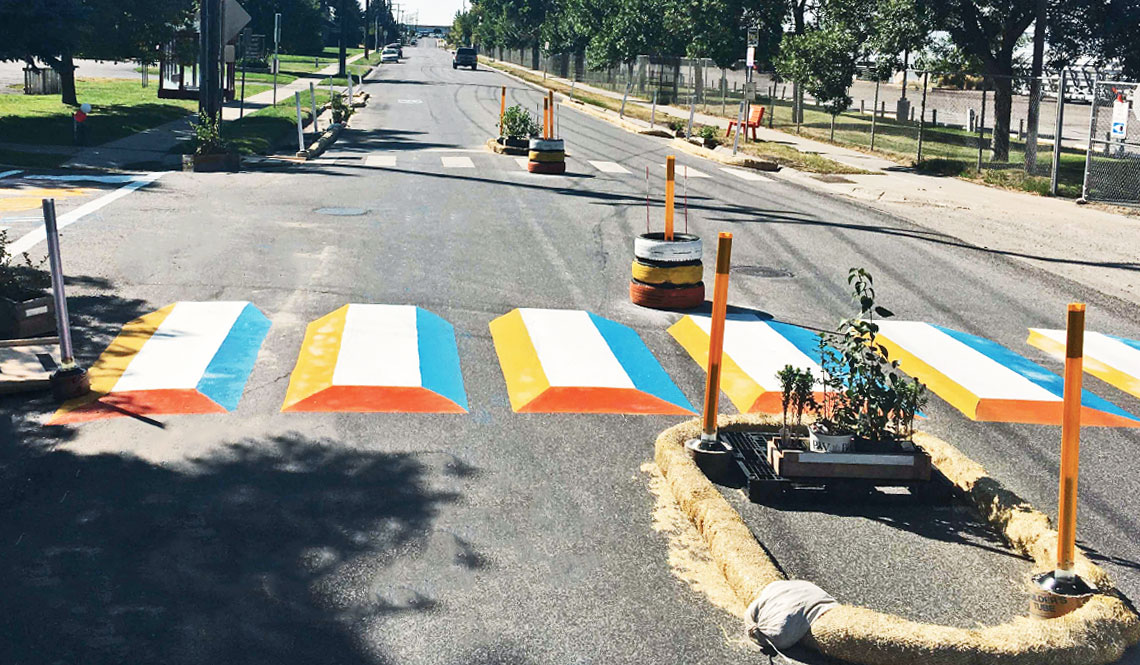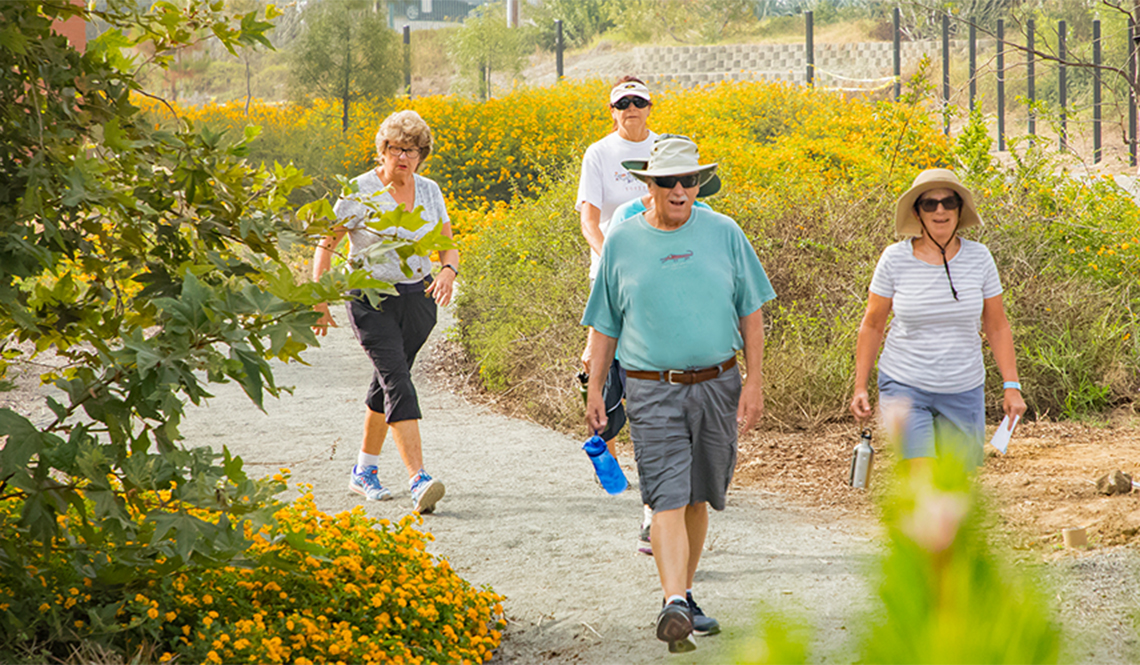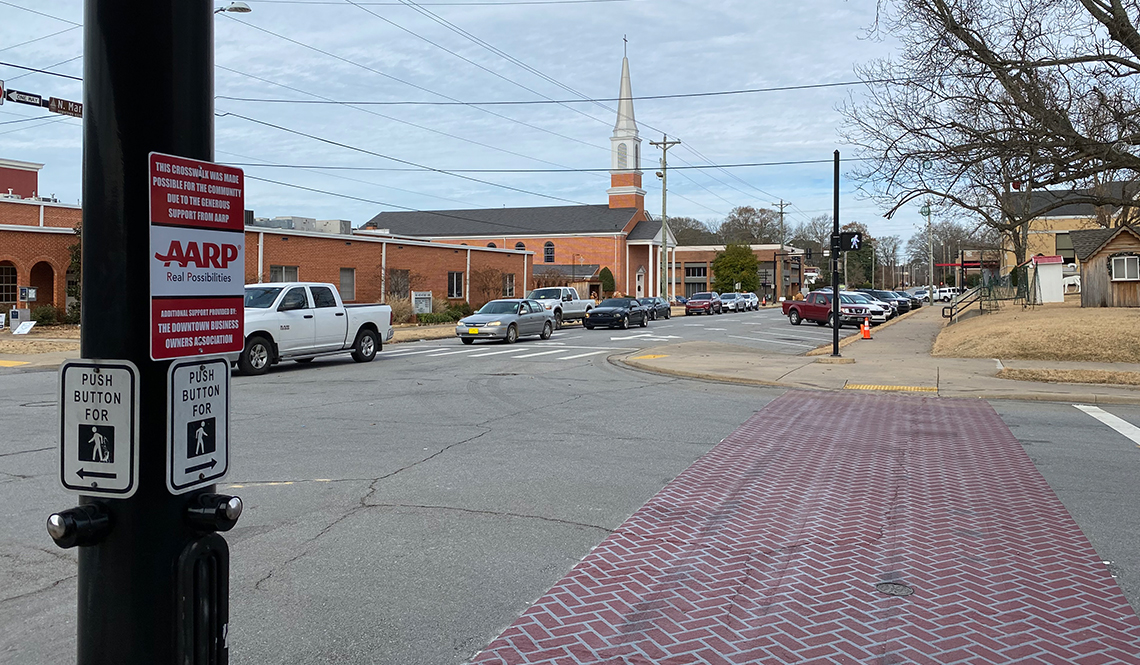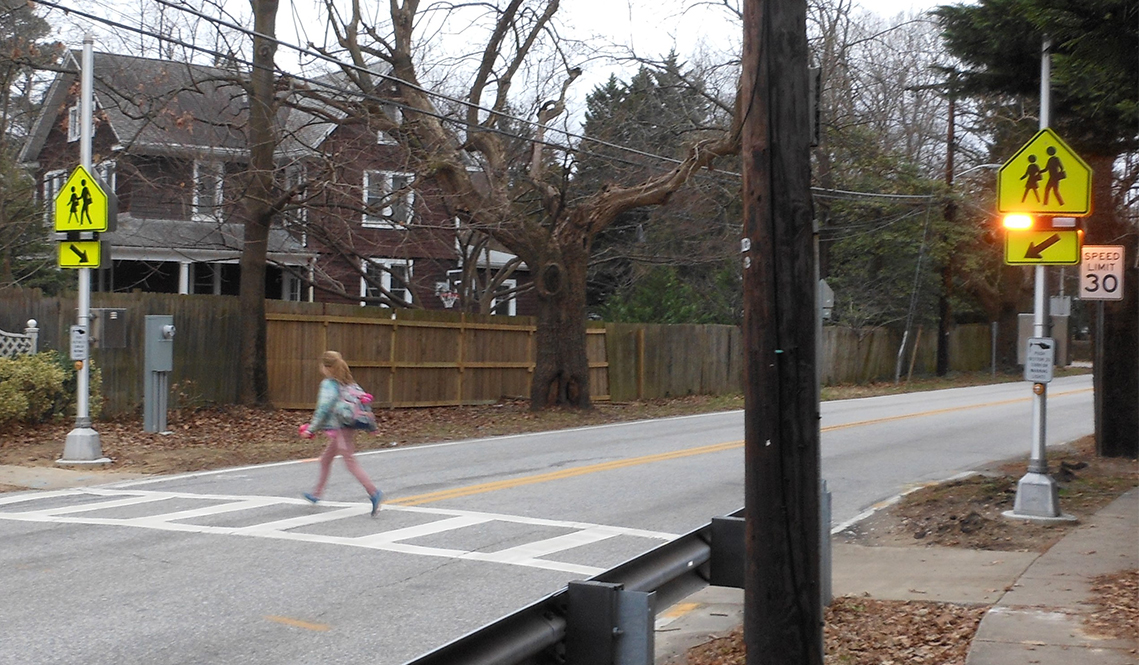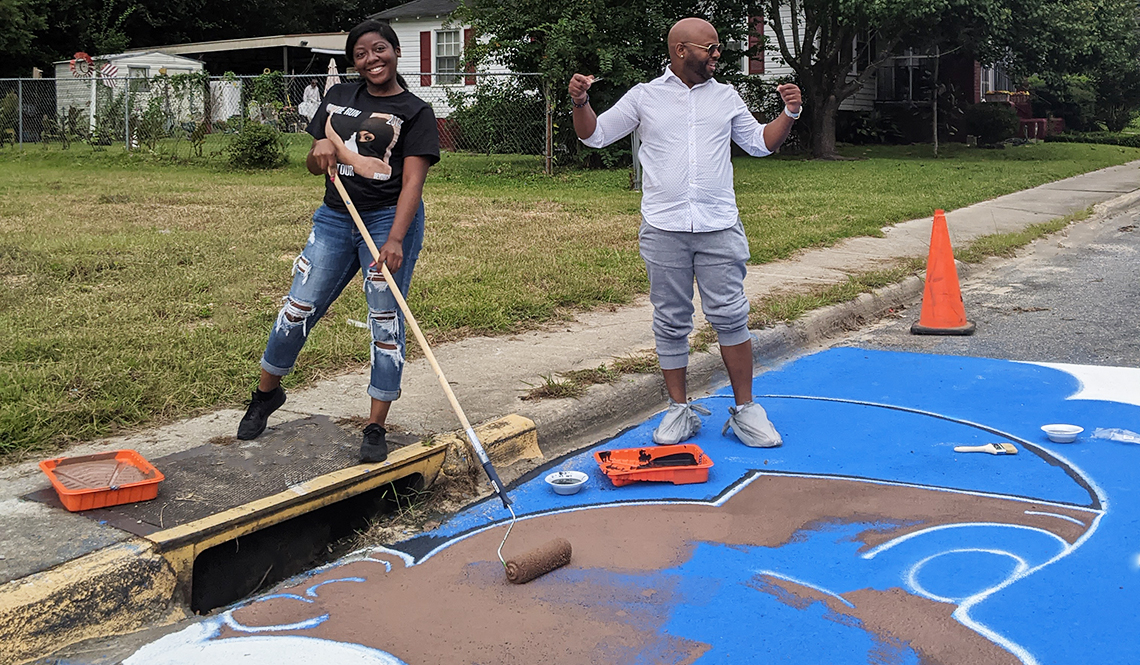Photo Album: Walkability Solutions
Here's a look at some of the walkable spaces and places helped or made possible by the AARP Community Challenge
The AARP Community Challenge has helped communities nationwide raise awareness about the need for local streets to be safe for all users, especially pedestrians. In many cases, AARP grant funds were used to both demonstrate and implement a solution for safer streets. Learn more below and click on the images to "visit" each community.
Northfield, Vermont
The pedestrians arrived soon after the purple paint dried. The 600-foot walk-bike lane was painted along Wall Street to connect the village's downtown (as well as a senior center and residential neighborhoods) to Dog River Park. "We noticed an uptick in the numbers of pedestrians using the lane versus traveling on the other side of the street," organizers at Northfield Common Connections told AARP. "It was so exciting to see runners, people with strollers, walkers, and others out walking the lane. The instantaneous use was the clearest indicator that our project was successful." One reason for the success is that prior to deciding whether and where a path was needed, volunteers used the AARP Walk Audit Tool Kit to assess the community's walkability strengths and weaknesses. The results informed where a walk-bike lane would be the most useful for and appreciated by residents.
Enid, Oklahoma
COVID and extreme weather didn't prevent staff and volunteers with Main Street Enid from creating what it believes are the first artistic crosswalks in the state. "The crosswalks catch the eyes of drivers, causing them to slow down and pay more attention to pedestrians, and it adds to our arts district," says Executive Director Natalie Beurlot about the four artistic crosswalks (including "Radiant City," pictured) designed by Jack Morgan, an architect at the nearby Vance Air Force Base. "Our community has loved this project and have asked for us to do more in the future." The project gained state and national recognition, most notably at the National Main Street Conference. Leaders from other cities have since contacted Main Street Enid for advice about implementing crosswalk art in their communities.
Hendersonville, North Carolina
In addition to creating two sidewalk murals to bring attention to the need for safe pedestrian pathways between the small city's two downtown districts, the project (called Downtown Art Route) wound up engaging more than 200 community volunteers, many from the local high school's art classes. The pictured promotion summarizes the steps involved in soliciting and then selecting the two winning designs. The "Hendo Bee Line" mural featured paintings of 20 pollinator flowers. The "Bear Crossing" mural features five hands spelling the word "Hendo" (the city's nickname) in American Sign Language. Each hand is a different skin color in honor of the community's racial and ethnic diversity.
Sioux Falls, South Dakota
By using tactical urbanism methods — which are lighter, faster and cheaper ways of creating infrastructure improvements — Downtown Sioux Falls, a civic improvement group supported by local businesses, added bump-outs (also called extended curbs), reflective delineator lines and large planters filled with flowers to create a visual and physical barrier between pedestrians and vehicles. The result: “Drivers actually slowed down!” said Joe Batcheller, the organization’s president. “The project helped reduce speeds by 20 percent on average.”
Honolulu, Hawaii
Organizers at the Waikiki Community Center originally planned to beautify Waikiki neighborhoods by painting utility boxes with cultural images. When that project got derailed due to permit challenges, they pivoted to do much needed sidewalk safety and repair work — something local older adults identified as a community need. Accompanying the efforts, the center educated residents about “defensive walking” (i.e., staying alert to one’s surroundings and potential risks from people and vehicles) and led an awareness campaign promoting pedestrian safety.
Charleston, South Carolina
Conflicts between motorists and pedestrians at intersections along the West Ashley Greenway (referred to as WAG) were becoming too common. An AARP Community Challenge grant was used to buy the paint and other supplies needed to create three artistic crosswalk murals and signage on the 8-mile walk-bike trail in order to slow vehicle traffic and draw attention to the safety needs of pedestrians and cyclists. Two-dozen volunteers age six to 70 participated in the installation. “Community members need to be able to get places without driving, and to feel safe when they’re walking and biking,” said project director Katie Zimmerman.
- Watch a video about the greenway project.
Henderson, North Carolina
The Henderson Art Walk leads visitors pass galleries, museums, murals and decorative crosswalks representing the area's history and culture. Just down the street from a piano keys crosswalk is a mural of city native Ben E. King, best known for the song “Stand By Me.” As a project participant noted, “As far as we can tell, our murals and crosswalks are the first public art pieces to be installed on our side of the railroad tracks, where some of our most economically disadvantaged citizens reside. This is arguably the first time the Flint Hill neighborhood has ever been featured in the local news in a positive light.”
Bozeman, Montana
An AARP Community Challenge grant helped the Western Transportation Institute at Montana State University and the city streets department of Bozeman, Montana, create demonstration crosswalks, painted illusionary speed bumps, mock medians (made from straw wattles) and a "mobile tool kit" for taking traffic-calming pop-up projects on the road.
Baltimore, Maryland
Bee Safe, a crosswalk art project, engaged local teens and other residents to design and create artistic crosswalks to slow traffic, increase the safety of crossings for school children and celebrate neighborhood identity. Working with local partners (including the Maryland Institute College of Art), volunteers installed three artistic crosswalks near Johnston Square Elementary School. The new crosswalks, flexible delineators, and painted bump-outs shortened the crossing distance by half at several intersections and added a crosswalk with accessible ramps at the main crossing point to and from the school. The work was done in compliance with Baltimore City's Complete Streets guidelines.
- Watch a local news video about the project.
Manhattan, Kansas
Curb extensions and pedestrian islands were installed at key intersections to enhance street safety at crossings along popular routes, including the pictured elementary school. "The semi-permanent crosswalk improvements have definitely increased the visibility of the crossings, while placing the priority of our roadways on people not cars," says Stephanie Peterson of the Flint Hills Metropolitan Planning Organization. "The project also shows that we can improve the walkability of our communities without having to spend hundreds of thousands of dollars, or more. Cost can no longer be used as a reason why we can't make a neighborhood or community safer for pedestrians."
Long Beach, California
For the first-ever 9.4-mile “Ranchos Walk” more than 400 pedestrians hiked along Long Beach’s high ridge from historic Rancho Los Alamitos in the city’s southeast to Rancho Los Cerritos in the north. The event introduced participants to streets and neighborhoods many had never seen, says Walk Long Beach Executive Director Steve Gerhart. Funded through a 2018 AARP Community Challenge grant, the gathering also highlighted the city’s agricultural history. (The two original ranchos, or land grants given to individuals who had been loyal to the Spanish Crown or, later, to the newly independent government of Mexico, date to the 1800s.) Walk organizers had expected half as many participants for the inaugural event, but residents of all ages flocked to the challenge — and the free tacos at the finish line!
Benton, Arkansas
Local leaders wanted the crosswalks in Benton’s downtown district to reflect the grandeur of the city’s elegant courthouse building. (Take a peek at the Saline County Courthouse.) They reached out to residents via social media, asking them to vote for one of four possible designs for new, artistic crosswalks. Nearly 2,000 responded and the initial vote was so close that a runoff vote was needed. The city ultimately installed two crosswalks showcasing the winning herringbone pattern, which despite its appearance is made from thin, preformed thermoplastic pavement panels rather than brick.
Tucson, Arizona
With brightly painted asphalt, street furniture and large urns hosting potted cacti and other native plants, Tucson’s Living Streets Alliance transformed the intersection of 6th Avenue and 7th Street, an area known locally as “Corbett Porch.” For years, the intersection had been dangerous ground for pedestrians and cyclists. By using inexpensive materials (paint, planters, pliable posts) to narrow the roadway and create a new, street-adjacent public space, the porch became a “street for people." Where only 1 in 4 drivers previously stopped at the intersection’s stop signs, a survey found that more than 1 in 3 were obeying the law. Meanwhile, Tucsonans flocked to the public space. Until it was removed in 2020 to make way for a permanent reconfiguration, the project proved to be such a popular place to see and be seen that it even had its own social media hashtag: #CorbettPorch.
Severna Park, Maryland
Both high- and low-tech solutions were employed to improve pedestrian safety in this suburban community near Maryland's capital city of Annapolis. Bright-orange, handheld pedestrian flags were made available at two crosswalks on Evergreen Road. At the pictured location, guardrails and planting strips between a sidewalk and street help protect pedestrians as does the visible crosswalk, school crossing signage, arrows and a flashing pedestrian-activated beacon. All provide a collective alert to drivers.
Macon, Georgia
Grant funds were used to improve pedestrian safety at three high-traffic corridors that connect to community centers. Crosswalk upgrades and on-street murals by local artists were among the traffic calming installations that took place as part of Bike Walk Macon’s 2020 Open Streets Macon event. Residents of all ages participated in the selection of the artistic creations. More than 120 community volunteers helped install the projects.
Salt Lake City, Utah
For as long as many west side residents could remember, an abandoned Union Pacific rail corridor in the Poplar Grove neighborhood of Salt Lake City, Utah, prevented them from safely walking or bicycling to the city’s downtown. Read the AARP article "A Walking Path Connects a Community" to learn how that's changed.
Page published December 2022
More About the AARP Community Challenge
- See more AARP Community Challenge Photo Albums »
- Look up grantees on the AARP Livable Communities Map »
- Visit AARP.org/CommunityChallenge »
Stay Informed — For Free!
AARP.org/Livable
Find articles, publications and more

